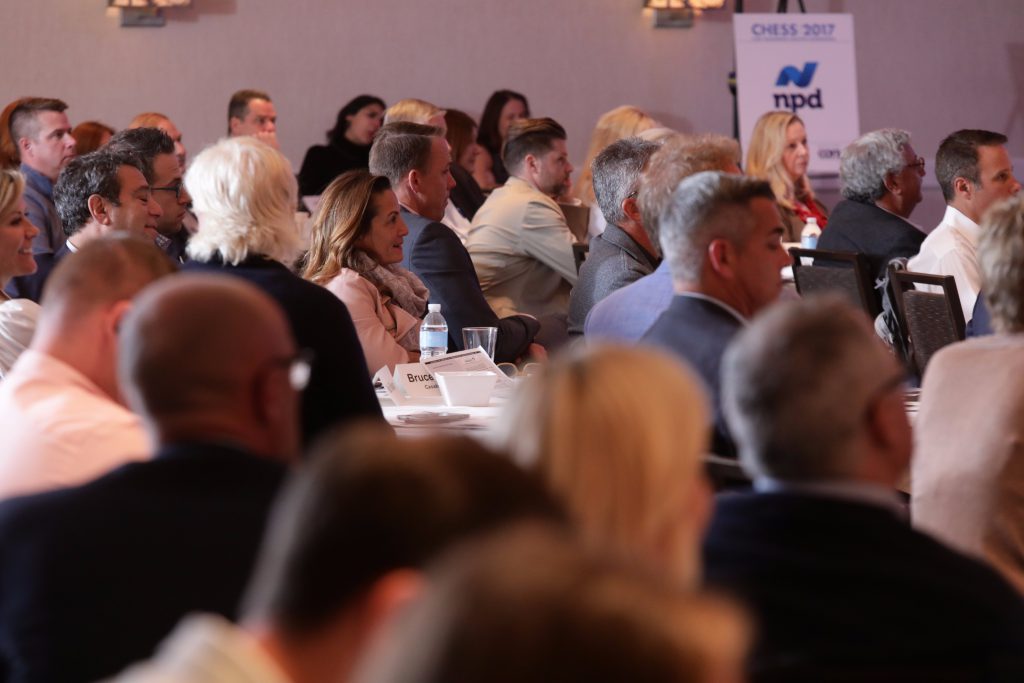Marshal Cohen, Chief Industry Analyst for the NPD Group, addressed current events in business and how the consumer has changed dramatically. We’ve allowed our businesses to become stagnant and boring, and the housewares categories must learn how to drive their exciting products out into the market. If the Apple phone is the most exciting product in the marketplace, we have a lot of work to do. But there are spots of good news.
He outlined the complex era for retailers and brands. Both sides of the industry face influences such as lifestage vs. age, spending vs. purchasing, sharing, discovery, nesting and consumers concerned about product origins. An important trend is committed consumption in an experiential, omni-present environment.
Macro Trends
Retail growth is slowing—a downward trend in the past six quarters. Exceptions are a few growing sectors such as prestige beauty, which reintroduced itself to the consumer. Makeup is the driver in the age of the selfie. Toys are growing because of licensed partnerships and online. Housewares is #3.
Cohen showed examples of year over year growth rates in dollars and percentage in various categories. Housewares is adapting to the online environment.
Amazon same day or one-day service is concentrated in major urban markets and reaches about 43% of the total U.S. population. Without regard to making money, Amazon is not concerned at this stage about profits.

Consumer Trends
Consumer-driven retail is in an age of discovery. Consumers are starting new trends in apparel, like vintage footwear and athletic/active wear clothing for all occasions. Consumer spending has shifted to creating memories, rather than buying objects. Spending is strong in travel and entertainment; air travel passenger counts are rising, RV sales are up as well as ticket sales for performances and theme parks. Notice opportunities in travel-related gear.
Retailers are Developing New Omni-Presence Tie-Ins
More than half of shoppers cross channels to order items online and pick them up in stores. Nearly one-third of shoppers say such services operate smoothly, yet would like digital help desks to help them shop in stores and would like personalized offers sent directly to them while they are shopping in stores. Consider lifestyle product lines and partner with other providers.
Experiential Retail
Focus on how they spend, not what they buy, especially when looking at the habits of 11-29 year olds, who are the future big spenders. They want to build memories, not wardrobes. They want things to do, not things to collect. Fashion and image were once #1 priority for consumers, today it’s about sharing—on social media or in person. Their favorite brand is not yours, but has become “Me.” They are creating themselves as a brand: “I Brands” = Just for Me.
The luxury market is no longer growing. Luxury is redefined, as consumers seek out vintage, recycled, or pre-owned products, share clothes and household products and rent rather than own. Debt and committed monthly expenses are high; discretionary spending power for 35 year olds is small. Half of meals purchased in restaurants is carried home to eat with family.
As in-store shopping declines because of online sales, impulse buys of related products also drops.
Opportunities
Catch up to the consumer. Stores need to get their personalities back, put specialty products back in stories. Understand travel. Recognize that innovation is the key to success—it drives growth. Omni-channel is displacement. Instead, build your Omni-presence – engage with the consumer before, during and after transactions. Brand advocacy comes with the omnipresent strategy.

Taking the Housewares Industry Further
Joe Derochowski, Home Industry Analyst for NPD Group, continued with advice on how to help the housewares industry find opportunities for growth.
He addressed home industry trends and consumer trends and how to make the most of these trends to grow your business. Housewares makers have the opportunity to make a positive impact for future generations.
Sales of home goods are in a five to ten-year growth window that hasn’t been seen since the 1970s: up 3% in the past year.
Population shifts over the next 10 years will create more life moments and opportunities for housewares sales. Millennials are the growing segment in the population, and they are entering the household formation stage with marriage and home purchasing. As Boomers age and downsize, their purchases grow for health and wellness products and services as well as home cooking. When they downsize, they buy new furnishings, appliances, tableware and other household products. Changes in habits for eating and cooking at home, entertaining and cleaning are driving more purchasing.
Housewares products need to increase share of mind as products compete with experiences. Learn about social media triggers, learn about how shoppers research your brands before purchase, how they use them and how they build community to become your brand advocates. Leverage life moments—like new home purchases and kitchen remodels—to trigger purchasing. Understand usage to help retailers solve problems.

Find Moments of Pain and Joy
Think of how the produce section in a grocery store has changed in the past decade. Consider the “I wish,” “I hate,” “I love” moments in every decision. What can we do to solve those moments in the morning when we have 11 minutes to have breakfast? What that mean for making food faster to prepare and carry? Lunch is typically salads and sandwiches. We spend the most time eating, but preparation is minimal. We want convenience. Make it easier to have left overs. Dinner: protein and vegetables tend to become one-dish meals. If we are entertaining, how can cookware coordinate several dishes prepared at once? Leverage smart technology to make this happen.
We are in a five-to-seven year growth period now; in 10 years, we’ll go back to 1990s. For the next agent of change, look to the percent of all women participating in work force. Female employment declines in early motherhood, yet 55 + is growing. Mom is a super hero, and sales of restaurant meals and frozen foods increase with her employment. The kitchen is the center of home, be ready for when that and continue to invest while this time is right.
In summary:
- Invest while time is ripe
- Enhance efforts to increase share of mine
- Continue to include consumer pain/joy moments along with design for innovation.



